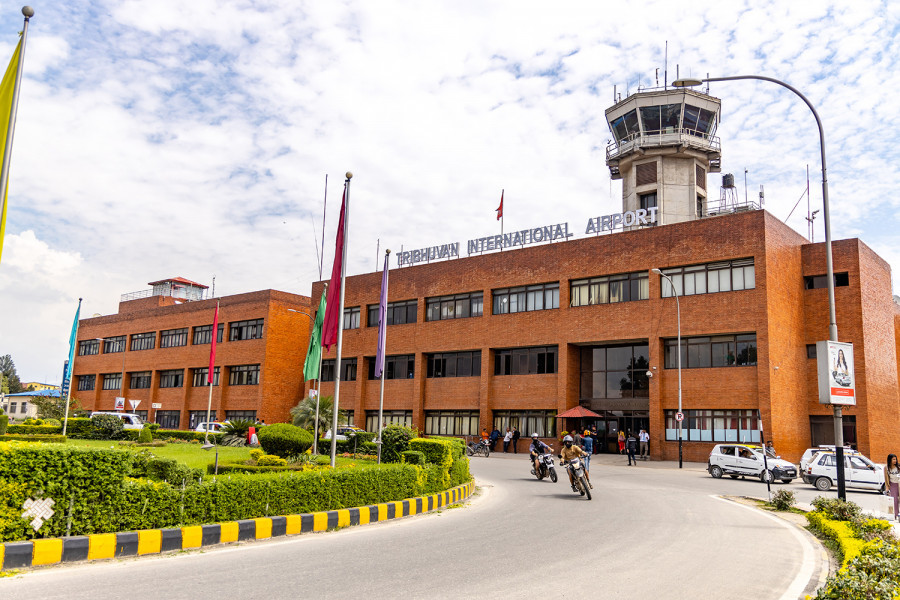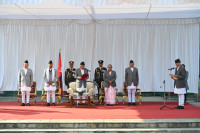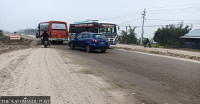National
International and domestic flights to resume starting August 17
Airlines and tourism entrepreneurs welcome the decision to lift flight restrictions that have been in place for over four months due to the Covid-19 pandemic.
Sangam Prasain
The government on Monday announced the resumption of international and domestic flights beginning August 17. The flights have remained suspended for over four months now in the wake of the Covid-19 pandemic.
Shiva Maya Tumbahangphe, the minister for law, justice and parliamentary affairs, told the Post that a Cabinet meeting on Monday decided to allow both international and domestic scheduled flights from August 17, as there “has been a decrease in the number of Covid-19 cases in the country”.
“All flights will be operated by following special health and safety protocols,” Tumbahangphe said.
On March 20, the government had banned all passengers, including Nepalis, from entering the country from the European Union territories, including the United Kingdom, West Asia, Gulf countries and countries like Iran, Turkey, Malaysia, South Korea and Japan.
Four days later, it had imposed a nationwide lockdown to prevent the spread of the coronavirus.
Nepal on Monday reported 186 new cases of Covid-19, taking the national tally to 17,844, with 40 deaths so far.
Dr Jageshwor Gautam, spokesperson for the Ministry of Health, told the daily press briefing on Monday that 11,868 Covid patients, or 66.51 percent of the total cases, have been discharged so far with 173 sent home in the past 24 hours.
The government says the decision to resume flights was taken as some countries have already started to lift the coronavirus restrictions.
"There are still some countries that are imposing entry restrictions. We will prepare reports on the countries where flights are not restricted and allow them to enter the country accordingly,” said Buddhi Sagar Lamichhane, joint-secretary at the Civil Aviation Ministry. “We will develop protocols and other required measures for the incoming flights.”
According to Lamichhane, for domestic flights, health and safety protocols have already been developed.
Birendra Bahadur Basnet, managing director of Buddha Air, welcomed the government’s decision, saying that they are all prepared for “new normal flights” with all passengers, airports and crew’s safety protocols in place.
“The Civil Aviation Authority of Nepal may develop necessary provisions for flight operations,” Basnet told the Post.
He said that they have completed an assessment on how many passengers would Kathmandu's domestic airport terminal accommodate if social distancing measures are followed.
“The airport can handle a maximum of 300 passengers per hour based on social distancing marking places,” said Basnet.
With the border closed and internal travel prohibited for nearly four months now, the once-booming tourism sector in Nepal is on the verge of a collapse, and it is not likely to recover any time soon, say industry insiders.
Yogendra Sakya, a travel trade entrepreneur, said the virus has put a stop to the normal routines of everyday life but the country cannot remain on the same routine forever.
“We have to do homework and hold extensive discussions with health professionals, the government and the industry players on how to build confidence of foreign tour operators and tourists as well,” said Sakya. “We have to be well prepared to handle the tourists.”
According to economists, the impact of the Covid-19 pandemic is likely to have a deeper and more far-reaching impact than natural disasters, including the 2015 earthquakes, as it is difficult to predict when the pandemic would be over and when tourists will feel safe enough to travel again.
Cancelling all scheduled flights to control the spread of the virus has affected all the sectors including the key projects as they need specialised manpower who are unable to enter Nepal, while tens of thousands of Nepali migrant workers have been stranded in different countries as they are unable to pay hefty chartered flights rates.
Tourism entrepreneurs said the industry can begin bookings for autumn if a tentative date for flight resumption is announced, no matter whether anyone comes or not.
The Covid-19 pandemic has also severely hit the domestic flight operators as their aircraft have been grounded for months and their expenses continue to rise, especially because of insurance and payment of employees salaries, despite the government deciding to waive the airport ground charges and other fees.
They said they are upbeat about the government decision to resume flights and that they are ready to follow the health and safety protocols.
“From passenger check-ins to disembarking, we will follow the aircraft disinfection procedure, screening of passengers for a safe operation of flights based on the health protocols,” said Basnet.
According to him, the airfare may reduce significantly as there will be competition among the airlines.
“We have decided to reduce the air fare by at least 30 percent,” said Basnet. “We hope that we will be able to sustain with the reduced airfare.”
For example, the lower fare in the Kathmandu-Biratnagar sector could come down to Rs2,800, from the normal fare of Rs6,000.
Travel trade entrepreneurs had been pressing the government to at least decide on a tentative timeline for reopening the country, as many of the world’s most popular travel destinations are welcoming international travellers this summer.
The government is also under pressure to resume regular services. There are thousands of Nepalis stranded in many countries who cannot afford chartered flights, as they cost three times the normal airfare, according to officials at the Civil Aviation Ministry.
Tourism industry insiders said if the country is able to attract at least 20 percent of last year’s tourists this autumn, it will tide over the industry until next spring.
Tourism simply shut down when the virus hit. There were 13, 30 and 100 foreign visitors to Nepal in April, May and June, respectively, according to the statistics of the Department of Immigration. And they were members of diplomatic missions, not sightseers.
In normal times, more than 100,000 cheerful vacationers would be getting off the planes at Kathmandu airport each month during this season.
Tourism entrepreneurs say that despite the pandemic and continuing restrictions on international travel, tourists are still inquiring about reservations for the holidays.
The industry has also requested the Tourism Ministry to reduce the mandatory quarantine facilities for foreign tourists.
Sakya said that the mandatory 14 days of quarantine would not encourage travellers to come to Nepal. “We have to follow what other countries are doing to make visitors safe and think about alternatives to reduce the mandatory quarantine provision,” he said.
For example, Japan plans to set up new coronavirus testing centres at three major airports as well as in central parts of the cities, as the country prepares to relax its travel restrictions.
Construction of the facilities is aimed at increasing the amount of polymerase chain reaction (PCR) tests to over 4,000 per day, with the health authorities hoping to reduce virus testing times to a few hours by using new methods.
Tourism is one of the major foreign currency earners for Nepal. According to the World Travel and Tourism Council, the travel and tourism's total contribution to the country’s gross domestic product stood at 7.9 percent in 2018.
Even though the service sector, like cafes and restaurants, have partially been opened since June 11, with no foreign tourists, their business has not been as good.
The tourism sector is worst affected and would take the longest time for revival.
“In such a difficult scenario, it’s all about survival,” said Sakya. “Only if we survive now, can we move ahead for revival.”




 7.12°C Kathmandu
7.12°C Kathmandu















